Input interpretation

Ca(OH)_2 calcium hydroxide + C_2H_2 acetylene ⟶ H_2O water + CaC_2 calcium carbide
Balanced equation
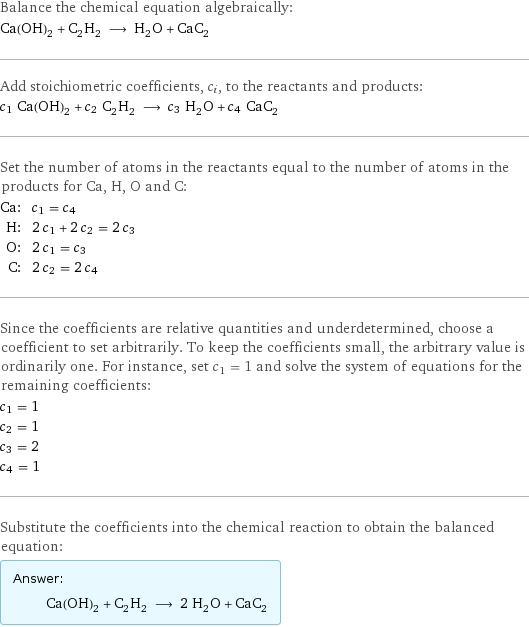
Balance the chemical equation algebraically: Ca(OH)_2 + C_2H_2 ⟶ H_2O + CaC_2 Add stoichiometric coefficients, c_i, to the reactants and products: c_1 Ca(OH)_2 + c_2 C_2H_2 ⟶ c_3 H_2O + c_4 CaC_2 Set the number of atoms in the reactants equal to the number of atoms in the products for Ca, H, O and C: Ca: | c_1 = c_4 H: | 2 c_1 + 2 c_2 = 2 c_3 O: | 2 c_1 = c_3 C: | 2 c_2 = 2 c_4 Since the coefficients are relative quantities and underdetermined, choose a coefficient to set arbitrarily. To keep the coefficients small, the arbitrary value is ordinarily one. For instance, set c_1 = 1 and solve the system of equations for the remaining coefficients: c_1 = 1 c_2 = 1 c_3 = 2 c_4 = 1 Substitute the coefficients into the chemical reaction to obtain the balanced equation: Answer: | | Ca(OH)_2 + C_2H_2 ⟶ 2 H_2O + CaC_2
Structures

+ ⟶ +
Names

calcium hydroxide + acetylene ⟶ water + calcium carbide
Reaction thermodynamics
Enthalpy
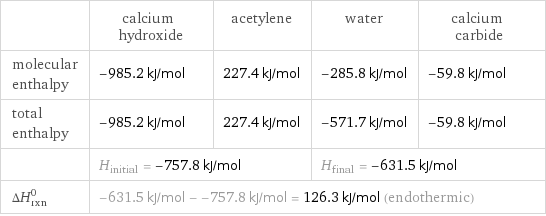
| calcium hydroxide | acetylene | water | calcium carbide molecular enthalpy | -985.2 kJ/mol | 227.4 kJ/mol | -285.8 kJ/mol | -59.8 kJ/mol total enthalpy | -985.2 kJ/mol | 227.4 kJ/mol | -571.7 kJ/mol | -59.8 kJ/mol | H_initial = -757.8 kJ/mol | | H_final = -631.5 kJ/mol | ΔH_rxn^0 | -631.5 kJ/mol - -757.8 kJ/mol = 126.3 kJ/mol (endothermic) | | |
Gibbs free energy
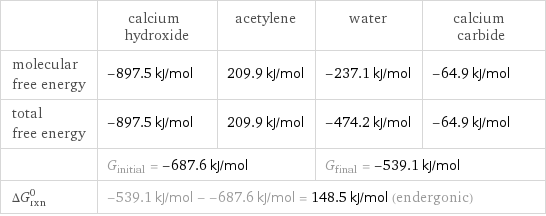
| calcium hydroxide | acetylene | water | calcium carbide molecular free energy | -897.5 kJ/mol | 209.9 kJ/mol | -237.1 kJ/mol | -64.9 kJ/mol total free energy | -897.5 kJ/mol | 209.9 kJ/mol | -474.2 kJ/mol | -64.9 kJ/mol | G_initial = -687.6 kJ/mol | | G_final = -539.1 kJ/mol | ΔG_rxn^0 | -539.1 kJ/mol - -687.6 kJ/mol = 148.5 kJ/mol (endergonic) | | |
Entropy
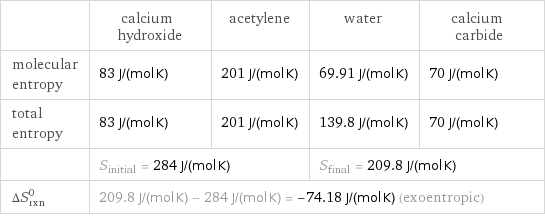
| calcium hydroxide | acetylene | water | calcium carbide molecular entropy | 83 J/(mol K) | 201 J/(mol K) | 69.91 J/(mol K) | 70 J/(mol K) total entropy | 83 J/(mol K) | 201 J/(mol K) | 139.8 J/(mol K) | 70 J/(mol K) | S_initial = 284 J/(mol K) | | S_final = 209.8 J/(mol K) | ΔS_rxn^0 | 209.8 J/(mol K) - 284 J/(mol K) = -74.18 J/(mol K) (exoentropic) | | |
Equilibrium constant
![Construct the equilibrium constant, K, expression for: Ca(OH)_2 + C_2H_2 ⟶ H_2O + CaC_2 Plan: • Balance the chemical equation. • Determine the stoichiometric numbers. • Assemble the activity expression for each chemical species. • Use the activity expressions to build the equilibrium constant expression. Write the balanced chemical equation: Ca(OH)_2 + C_2H_2 ⟶ 2 H_2O + CaC_2 Assign stoichiometric numbers, ν_i, using the stoichiometric coefficients, c_i, from the balanced chemical equation in the following manner: ν_i = -c_i for reactants and ν_i = c_i for products: chemical species | c_i | ν_i Ca(OH)_2 | 1 | -1 C_2H_2 | 1 | -1 H_2O | 2 | 2 CaC_2 | 1 | 1 Assemble the activity expressions accounting for the state of matter and ν_i: chemical species | c_i | ν_i | activity expression Ca(OH)_2 | 1 | -1 | ([Ca(OH)2])^(-1) C_2H_2 | 1 | -1 | ([C2H2])^(-1) H_2O | 2 | 2 | ([H2O])^2 CaC_2 | 1 | 1 | [CaC2] The equilibrium constant symbol in the concentration basis is: K_c Mulitply the activity expressions to arrive at the K_c expression: Answer: | | K_c = ([Ca(OH)2])^(-1) ([C2H2])^(-1) ([H2O])^2 [CaC2] = (([H2O])^2 [CaC2])/([Ca(OH)2] [C2H2])](../image_source/701502b0fdee4df5f38d5e4631f07c19.png)
Construct the equilibrium constant, K, expression for: Ca(OH)_2 + C_2H_2 ⟶ H_2O + CaC_2 Plan: • Balance the chemical equation. • Determine the stoichiometric numbers. • Assemble the activity expression for each chemical species. • Use the activity expressions to build the equilibrium constant expression. Write the balanced chemical equation: Ca(OH)_2 + C_2H_2 ⟶ 2 H_2O + CaC_2 Assign stoichiometric numbers, ν_i, using the stoichiometric coefficients, c_i, from the balanced chemical equation in the following manner: ν_i = -c_i for reactants and ν_i = c_i for products: chemical species | c_i | ν_i Ca(OH)_2 | 1 | -1 C_2H_2 | 1 | -1 H_2O | 2 | 2 CaC_2 | 1 | 1 Assemble the activity expressions accounting for the state of matter and ν_i: chemical species | c_i | ν_i | activity expression Ca(OH)_2 | 1 | -1 | ([Ca(OH)2])^(-1) C_2H_2 | 1 | -1 | ([C2H2])^(-1) H_2O | 2 | 2 | ([H2O])^2 CaC_2 | 1 | 1 | [CaC2] The equilibrium constant symbol in the concentration basis is: K_c Mulitply the activity expressions to arrive at the K_c expression: Answer: | | K_c = ([Ca(OH)2])^(-1) ([C2H2])^(-1) ([H2O])^2 [CaC2] = (([H2O])^2 [CaC2])/([Ca(OH)2] [C2H2])
Rate of reaction
![Construct the rate of reaction expression for: Ca(OH)_2 + C_2H_2 ⟶ H_2O + CaC_2 Plan: • Balance the chemical equation. • Determine the stoichiometric numbers. • Assemble the rate term for each chemical species. • Write the rate of reaction expression. Write the balanced chemical equation: Ca(OH)_2 + C_2H_2 ⟶ 2 H_2O + CaC_2 Assign stoichiometric numbers, ν_i, using the stoichiometric coefficients, c_i, from the balanced chemical equation in the following manner: ν_i = -c_i for reactants and ν_i = c_i for products: chemical species | c_i | ν_i Ca(OH)_2 | 1 | -1 C_2H_2 | 1 | -1 H_2O | 2 | 2 CaC_2 | 1 | 1 The rate term for each chemical species, B_i, is 1/ν_i(Δ[B_i])/(Δt) where [B_i] is the amount concentration and t is time: chemical species | c_i | ν_i | rate term Ca(OH)_2 | 1 | -1 | -(Δ[Ca(OH)2])/(Δt) C_2H_2 | 1 | -1 | -(Δ[C2H2])/(Δt) H_2O | 2 | 2 | 1/2 (Δ[H2O])/(Δt) CaC_2 | 1 | 1 | (Δ[CaC2])/(Δt) (for infinitesimal rate of change, replace Δ with d) Set the rate terms equal to each other to arrive at the rate expression: Answer: | | rate = -(Δ[Ca(OH)2])/(Δt) = -(Δ[C2H2])/(Δt) = 1/2 (Δ[H2O])/(Δt) = (Δ[CaC2])/(Δt) (assuming constant volume and no accumulation of intermediates or side products)](../image_source/511c88cbe2a7244d6965cff246f57d5d.png)
Construct the rate of reaction expression for: Ca(OH)_2 + C_2H_2 ⟶ H_2O + CaC_2 Plan: • Balance the chemical equation. • Determine the stoichiometric numbers. • Assemble the rate term for each chemical species. • Write the rate of reaction expression. Write the balanced chemical equation: Ca(OH)_2 + C_2H_2 ⟶ 2 H_2O + CaC_2 Assign stoichiometric numbers, ν_i, using the stoichiometric coefficients, c_i, from the balanced chemical equation in the following manner: ν_i = -c_i for reactants and ν_i = c_i for products: chemical species | c_i | ν_i Ca(OH)_2 | 1 | -1 C_2H_2 | 1 | -1 H_2O | 2 | 2 CaC_2 | 1 | 1 The rate term for each chemical species, B_i, is 1/ν_i(Δ[B_i])/(Δt) where [B_i] is the amount concentration and t is time: chemical species | c_i | ν_i | rate term Ca(OH)_2 | 1 | -1 | -(Δ[Ca(OH)2])/(Δt) C_2H_2 | 1 | -1 | -(Δ[C2H2])/(Δt) H_2O | 2 | 2 | 1/2 (Δ[H2O])/(Δt) CaC_2 | 1 | 1 | (Δ[CaC2])/(Δt) (for infinitesimal rate of change, replace Δ with d) Set the rate terms equal to each other to arrive at the rate expression: Answer: | | rate = -(Δ[Ca(OH)2])/(Δt) = -(Δ[C2H2])/(Δt) = 1/2 (Δ[H2O])/(Δt) = (Δ[CaC2])/(Δt) (assuming constant volume and no accumulation of intermediates or side products)
Chemical names and formulas

| calcium hydroxide | acetylene | water | calcium carbide formula | Ca(OH)_2 | C_2H_2 | H_2O | CaC_2 Hill formula | CaH_2O_2 | C_2H_2 | H_2O | C_2Ca name | calcium hydroxide | acetylene | water | calcium carbide IUPAC name | calcium dihydroxide | acetylene | water | calcium acetylide
Substance properties
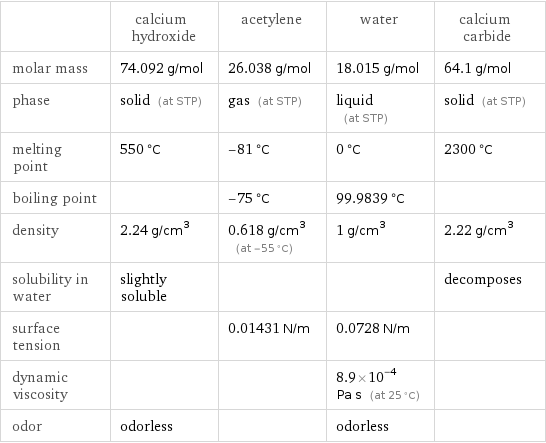
| calcium hydroxide | acetylene | water | calcium carbide molar mass | 74.092 g/mol | 26.038 g/mol | 18.015 g/mol | 64.1 g/mol phase | solid (at STP) | gas (at STP) | liquid (at STP) | solid (at STP) melting point | 550 °C | -81 °C | 0 °C | 2300 °C boiling point | | -75 °C | 99.9839 °C | density | 2.24 g/cm^3 | 0.618 g/cm^3 (at -55 °C) | 1 g/cm^3 | 2.22 g/cm^3 solubility in water | slightly soluble | | | decomposes surface tension | | 0.01431 N/m | 0.0728 N/m | dynamic viscosity | | | 8.9×10^-4 Pa s (at 25 °C) | odor | odorless | | odorless |
Units
